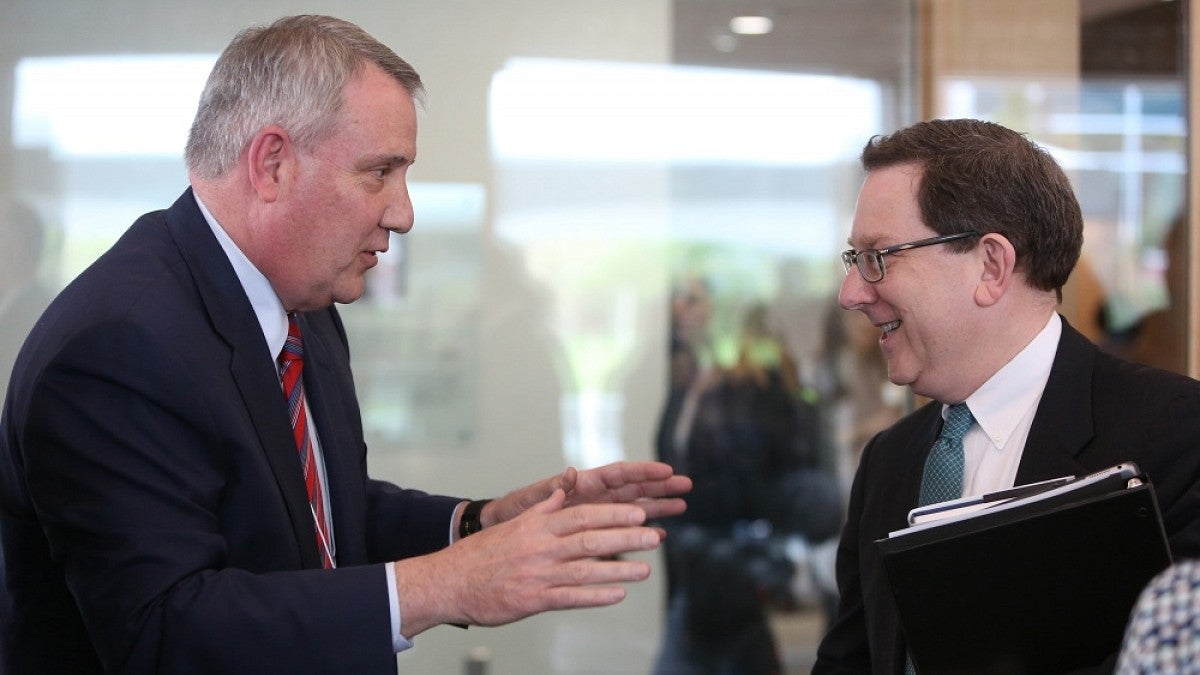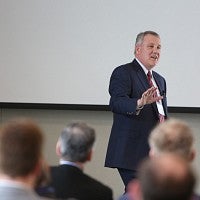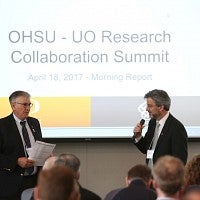Two new research facilities being built 110 miles apart may move the University of Oregon and Oregon Health & Science University closer together than they’ve been in more than 40 years.
In a daylong summit last month at Western Oregon University in Monmouth, about 90 UO and OHSU researchers from a variety of disciplines brainstormed possible collaborations. Both institutions are currently developing major new research facilities thanks to unprecedented gifts from the same benefactor.
“This was a day about setting the stage for deepening the relationship between OHSU and the UO, and begin to further conversations about broader regional initiatives, especially between two Knight campuses,” said UO biologist Patrick Phillips, acting executive director of the Phil and Penny Knight Campus for Accelerating Scientific Impact.
Construction of the UO’s Knight Campus will begin next year. Ground was broken last June in Portland for a new research building for the OHSU Knight Cancer Institute. Both projects are $1 billion initiatives triggered by separate $500 million gifts from Nike founder Phil Knight and his wife, Penny.
The UO and Willamette University joined their medical programs in Portland in the early 1900s, creating the UO Medical School. In 1974, it became independent as OHSU and now has schools of medicine, nursing, dentistry, and public health, a College of Pharmacy, and extensive research programs.
The Knights’ gifts to the two institutions have “energized our desire to expand collaborations,” said UO President Michael Schill.
“The University of Oregon and OHSU have the opportunity to leverage our collaboration in a way that amplifies our work, amplifies our reach and strengthens both of our universities’ strategic plans,” Schill said. “We have the natural connections to work together. We have research connections. We have a shared history. We have a shared love for our state.”
OHSU President Joe Robertson noted the tremendous potential of future collaborations. The more resources are combined, the more likely it is to realize breakthroughs, he said.
“Great advances in science are occurring at the interface of disciplines,” Robertson said. “By working together, we’ll maximize the state’s potential for discovery and application.”
Areas identified as ripe for research collaborations drew from biology, chemistry, computer and information sciences, developmental psychology, drug development, genetics, materials science, and neuroscience. They should be pursued, participants said, in ways that complement existing strengths at each institution. While some specific areas were singled out, broader interdisciplinary approaches were seen as vital.
A strong route for multiple collaborations, the participants said, exists because of the UO’s use of model organisms such as zebrafish, roundworms, and mice, and OHSU’s programs that involve both humans and nonhuman primates. In combination with extensive biological imaging technologies at the two institutions, researchers would speed discoveries to clinical trials and improve drug delivery techniques by tapping input from UO chemists and materials scientists for improving drug delivery.
A portion of the day was dedicated to breakout discussions with between eight and 12 researchers from similar fields focusing on similar topics and then reporting out to the entire group. The participants were encouraged to identify challenges to working together and suggesting ways to address them.
Many breakout sessions identified similar barriers: data interpretation and storage, distance between the two institutions and administrative structures.
As potential solutions, participants proposed linking research and clinical databases, especially massive amounts of imaging data, between the campuses to foster collaboration on improved visualization and analytical technologies. Jointly run websites also were suggested.
To bridge the distance between Eugene and Portland, participants suggested direct transportation between the campuses and regular conferences to bring researchers and their students together to discuss projects that would be enhanced by collaboration.
Other common threads focused on ways to encourage entrepreneurship, connect with industry partners — especially in technological and pharmaceutical fields — and joint educational and internship programs that would allow undergraduate- and graduate-level students to move back and forth between the UO and OHSU.
Because both campuses are engaging in significant faculty recruitment efforts, the participants suggested the use of joint search committees where relevant and developing a protocol to consider joint appointments at the two institutions.
How the two campuses might collaborate administratively drew attention, too. There was consensus that the development of a shared overall vision for future collaboration was necessary. The participants saw the separate rules and regulations of each campus as potential barriers that need to be identified and resolved through administrative leadership.
Daniel Dorsa, OHSU’s senior vice president for research, and David Conover, the UO’s vice president for research and innovation, both said there is hard work ahead but bringing the two institutions closer together is in the best interest of both organizations and for the state of Oregon to assure the best use of resources.
“The impact of discoveries to be made at both institutions will be much greater if we combine our efforts,” Dorsa said.
“Our two institutions have a lot to gain by working together,” Conover said. "We have the right combination of top-down support from the administration and bottom-up support from the faculty. I think there really is a sense of shared vision and purpose that can help lead us forward.”
—By Jim Barlow, University Communications






